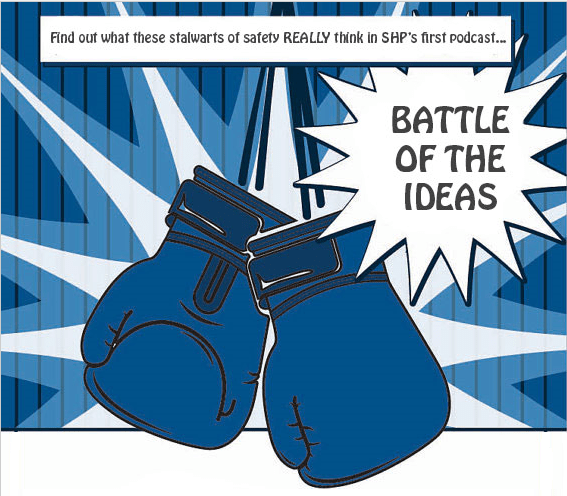 At the end of November this year, SHP ran its first ever podcast, where five leaders in health and safety came together to discuss key ideas and opinions around health and safety.
At the end of November this year, SHP ran its first ever podcast, where five leaders in health and safety came together to discuss key ideas and opinions around health and safety.
We asked:
- Is safety really broken?
- What’s the point in zero harm?
- Is the absence of acidents a positive thing?
- Is ‘safety differently’ a revolution or an evolution?
Ruth Gallagher, John Green, Steve Hails, Clive Johnson and Tim Marsh took to SHP’s airwaves to battle out the key ideas of leadership and culture in health and safety.
We learnt how they strive to create positive safety cultures through different approaches.
Here, the speakers answer your questions put forward during the podcast.
- How do you avoid sounding negative and accentuate the positives of a good health, safety & welfare culture?
 Tim Marsh: We build a strong culture by, in part, focusing on day to day behaviours. As well as the obvious risk reduction behaviours towards the far end of Reason’s Cheese model (holding hand rails, wearing PPE etc) these might include delivering a toolbox talk that’s concise, powerful and impactful and that includes a large element of genuine dialogue.
Tim Marsh: We build a strong culture by, in part, focusing on day to day behaviours. As well as the obvious risk reduction behaviours towards the far end of Reason’s Cheese model (holding hand rails, wearing PPE etc) these might include delivering a toolbox talk that’s concise, powerful and impactful and that includes a large element of genuine dialogue.
Because of the way our brains are hard-wired, praise is 20 times as powerful at changing behaviour but if that’s the main basis of your culture change it can be a bit passive and person focused as you rather have to wait to see something to praise!
It’s better to facilitate ‘discovered learning’ moments through effective coaching and through genuine empowerment (workforce involvement in the analysis and enhancement process). Countless opportunities for praise will flow automatically from those approaches.
Setting the tone through questions typically used is also key. Infamously, for example, the OIM of one of Piper Alpha’s sister platforms (Claymore) refused to stop pumping oil until he’d confirmation from Aberdeen that this was acceptable. He’d been conditioned by years of being asked “Why did you switch off?” (Meaning: ‘you’d better have a good reason for that’).
More recently, organisations are mindful to ask “Why did you think it safe to switch back on?” (Meaning ‘you have 20 years of operational experience – of course you had a good reason – what happened?)
2. Is it time to do away with the health and safety profession? Does the existence of the health and safety profession proliferate lack of accountability and exaggerate the burden of health and safety legislation?
 John Green: I think everyone approaches ‘doing’ HSE with the right intentions and I think that everyone tries their very best but over the years our efforts have become misdirected. We have without doubt built up our roles by focusing on the costs of non-compliance both financially and in regard to reputation.
John Green: I think everyone approaches ‘doing’ HSE with the right intentions and I think that everyone tries their very best but over the years our efforts have become misdirected. We have without doubt built up our roles by focusing on the costs of non-compliance both financially and in regard to reputation.
We have been very good and creating an atmosphere of fear when it comes to safety in particular – and we are now faced with that legacy.
We need to have the courage to face these issues and to jettison the approaches of the past no matter how well they might have served us and move on. I don’t think this means the end of the profession but the start of a significant shift in both what we do and how we do it.
We need to become coaches and mentors and organisations will have to use us in very different ways. We need to support the capacity of businesses to respond to the daily changes that they face and build a resilient future rather than simply oppose of limit choices.
In your opinion what have you done to positively influence people onsite who do not have a good understanding of the English Language?
 Steve Hails: Tideway, working in collaboration with Loughborough and Caledonian Universities are the first infrastructure programme to introduce a communications assessment at induction.
Steve Hails: Tideway, working in collaboration with Loughborough and Caledonian Universities are the first infrastructure programme to introduce a communications assessment at induction.
The assessment is intended to test the individual’s understanding of written and spoken English as well as common signage that may be encountered on a construction site. The programme is intended to identify where individuals may have difficulties and therefore alert us of the need for additional control to minimise risk to that individual and the wider groups he/she may interact with.
Everyone who works on Tideway must complete the communications assessment before they are inducted and subsequently allowed on site.
What are the most effective pro-active safety initiatives the panel have used to date?
 Clive Johnson: At Land Securities, our ustomer Improvement Groups have delivered real success, see below these groups have driven real change across the business and given us a consistent approach over six disciplines, reducing incidents, insurance claims etc. and a great place to build relationships and to share any leanings.
Clive Johnson: At Land Securities, our ustomer Improvement Groups have delivered real success, see below these groups have driven real change across the business and given us a consistent approach over six disciplines, reducing incidents, insurance claims etc. and a great place to build relationships and to share any leanings.
We even have companies who still attend but don’t currently carry out any works for LS, a real testament to their success. Happy to discuss further if required.
What does the panel think of the concept of unconscious behaviours at work being the key influencing factor in accidents rather than conscious decision making?
Tim Marsh: As well as learning and leadership, my own work has focused on the power of subconscious norms and unspoken assumptions on driving our day to day behaviour. Primacy, recency and availability heuristics are well known – as is risk perception skewed by primary fears. (The switch to cars from planes following 9:11 perhaps the best known example). Some other examples of subconscious issues impacting on safety:
At a bio-chemical level if we’re stressed we’re likely to by full of cortisol which tends to make us jumpy and risk averse but likely to over-react impetuously at times. (Like a misfiring motorbike). Awash with the more positive oxytocin however (because we’ve just been praised or empowered) and we’re likely to be full of pro-social bonhomie!
Another example: on Deepwater the person worried about readings was assured about the ‘bladder effect’ (it doesn’t exist). Official reports stated that his on-going concerns were met with robust humour – which in plain English means that when his peers laughed at his anxiety and ‘took the mick’ he fell quiet.
A smirk from a colleague often largely subconsciously asserts a norm. Likewise as we all know being told on a date ‘You’re a really nice bloke but … ‘ means that the evening will not end well just as ‘Safely, but by Friday’ let’s employees know what’s expected.
Instinctively, in these situations, we ‘know’ what’s wanted but later, at an inquest perhaps, might struggle to articulate how exactly we ‘knew’.
How do you ensure that organisations you support focus on health as well as safety?
 Steve Hails: At Tideway health performance is an integral part of the overall health and safety performance index (HSPI) which is the mechanism for measuring leading indicators within the supply chain.
Steve Hails: At Tideway health performance is an integral part of the overall health and safety performance index (HSPI) which is the mechanism for measuring leading indicators within the supply chain.
The measures apply for all levels of the supply chain, not just the Principal Contractors. Included within the current measures are KPIs relating to designing out health risk as well as a newly introduced health impact frequency rate (HIFR) which is a mechanism for identifying health-related risks within the workplace and normalising them per 100,000 working hours. This encourages reporting and a focus on health.
The overall status of their health and wellbeing programmes is also evaluated and measured against a defined maturity matrix. This gives clear goals to evolve and grow to the next level of maturity in a number of key areas including mental health and respiratory health.
What does health and safety look like in 2020?
 John Green: 2020 isn’t that far off and I would hope that we would have made significant steps towards creating an approach that is built on the 3 principles that we use in Laing O’Rourke:
John Green: 2020 isn’t that far off and I would hope that we would have made significant steps towards creating an approach that is built on the 3 principles that we use in Laing O’Rourke:
- People are the solution they are not the problem
- Safety is about building positives not the absence of negatives
- Safety is an ethical responsibility and not a bureaucratic activity.
How do you define ‘wellbeing’ and where do you believe it ranks alongside other health and safety concerns such as accident prevention?
 Clive Johnson: Wellbeing is the third pillar to ‘health’, occupational hygiene and occupational health are the other two. Health/wellbeing is integral to the way we should work, it should be given equal billing.
Clive Johnson: Wellbeing is the third pillar to ‘health’, occupational hygiene and occupational health are the other two. Health/wellbeing is integral to the way we should work, it should be given equal billing.
Generally HR are responsible for the wellbeing bit but as we progress and become more mature it really does sit with health and safety or even joint ownership.
There are many strands to wellbeing one of which is the environment that we work in, creating the right work environment is a crucial part of it, bearing in mind we spend most of our lives in the workplace this in turn leads to a happier and healthier workforce.
As leaders the question we should ask is: “What can I do to help you do your job better”? e.g. flexible working and getting a healthy work life balance is key in any team or business success.
How will technology (AI, VR, Internet of Things) change health and safety?
 Steve Hails: We have to reach out and embrace the technology that is available. We have already seen improvements in the control of plant, for example sprayed concrete lining machines are now controlled with something that resembles an Xbox controller.
Steve Hails: We have to reach out and embrace the technology that is available. We have already seen improvements in the control of plant, for example sprayed concrete lining machines are now controlled with something that resembles an Xbox controller.
We need to continue to invest in this technology to look at how we can remove individuals entirely from the area of risk. Driverless cars are being tested in the UK – I believe it won’t be long before we have remote-controlled plant operating on our sites.
I also believe we will start to see huge growth in wearable technology – monitoring persons and the environments in which they work to have real-time monitoring of health risk.
VR is already being used in the design phase and integrating with BIM modelling to identify risks at the earliest stage and eliminate.
And with talk of more applications for 3-D printing etc these will be exciting times for risk elimination.
Is ‘safety differently the OHS equivalent of Seligman’s positive psychology?
 Tim Marsh: Yes and no. Explicitly so to the extent that it very appropriately focuses on learning what goes well on a typical day – and what we need to do to ensure that continues – rather than what goes wrong.
Tim Marsh: Yes and no. Explicitly so to the extent that it very appropriately focuses on learning what goes well on a typical day – and what we need to do to ensure that continues – rather than what goes wrong.
A word of warning though: positive psychology generally focuses very much on the person and this overlaps with a big criticism of behavioural-based safety (BBS).
Just Culture shows that around 90% of the causes of unsafe acts and conditions are organisational (unintentional errors through ergonomics and lack of training, violations caused by situational factors and cultural pressures).
The criticism of BBS is that we therefore want to focus 90% of our time on the organisation – not the person – analysing objectively and facilitating enhancement.
For example, a classic study from positive psychology (from the resilience field) shows that stress is of course bad for you but that its impact is almost entirely mitigated if the person in question does not believe that stress is harmful. (A variation on: ‘between stimulus and response there is choice’ and the ‘glass is half full’ mentality).
We’ve seen ‘if you can walk on these hot coals you can do anything – so be safe’ BBS initiatives that focus entirely on the person so we need to be wary of someone reading the same source material about positive psychology, hoisting a SD banner – then charging off in completely the wrong direction proclaiming ‘it’s all in the mind’!
The one-time trend for ‘Advanced’ BBS’ – in essence using NLP type techniques to ‘enhance’ the corrective coaching of individuals – is a case in point.
How do you deal with employees who are not actively involving themselves or who resist the leaders safety ideals?
 Clive Johnson: My approach has always been the hearts and mind approach and get them to be part of the ideas/initiatives (not the compliance bit that just generally just switches them off).
Clive Johnson: My approach has always been the hearts and mind approach and get them to be part of the ideas/initiatives (not the compliance bit that just generally just switches them off).
It’s all about engaging with them, they are your internal customers and key to the success of any health and safety initiative or idea. This is why the softer skills in the toolbox of any health and safety practitioner is generally the key to success not the clock of compliance.
As a result their attitude changes and they join you in quest to get health and safety integral to the overall management of the business and not the department that are quite often seen as blockers.
Prof. Sidney Dekker thinks that “Safety has become a bureaucratic accountability to people up, rather than an ethical responsibility for people in the organisation – it’s become a situation where we have to report the absence of negatives (i.e. lost time injuries), and that people are the problem to be controlled….” Do you agree with him?
 John Green: I agree whole heartedly with Sidney. There are numerous problems associated with this approach.
John Green: I agree whole heartedly with Sidney. There are numerous problems associated with this approach.
1) Errors are not failures of character, but normally and systematically connected to features of the complexity of your work environment — its tools, technologies, tasks, organisation, and coordination.
2) Errors are not causes of trouble, but (often predictable) symptoms of psychological, logistical, organisational and engineering design issues.
3) Failures are often preceded by long periods of ‘drift’ where borrowing against safety margins is increasingly accepted and expected and goes largely unnoticed—by workers, supervisors, managers, directors, regulators—because it makes sense and has few overtly negative consequences.
4) Resilient organisations do not invest in fine-tuning their lagging indicators of negatives (weak signals), but rather invest in identifying and bolstering their strong signals of resilience—the ability to keep harmful influences at bay without knowing in detail what those might be or when and where they might appear.
5) Organisational conditions that make disclosure and reporting of signals of danger and error possible (to supervisor, colleagues, client, and contractor) can be put in place. This involves managerial decisions around confidentiality, honesty, legality, protection of data, and practicality.
6) A just culture is one where learning from failure and accountability for failure work in each other’s favour, not against each other. This is possible if accountability is forward-looking and restorative, not backward-looking and punitive. Restructuring of an organisation’s accountability mechanisms, so as to favour learning, is possible. This involves a critical look at sanctions, incentives, but also trust and confidence
The Safety Conversation Podcast: Listen now!
The Safety Conversation with SHP (previously the Safety and Health Podcast) aims to bring you the latest news, insights and legislation updates in the form of interviews, discussions and panel debates from leading figures within the profession.
Find us on Apple Podcasts, Spotify and Google Podcasts, subscribe and join the conversation today!


 Tim Marsh: We build a strong culture by, in part, focusing on day to day behaviours. As well as the obvious risk reduction behaviours towards the far end of Reason’s Cheese model (holding hand rails, wearing PPE etc) these might include delivering a toolbox talk that’s concise, powerful and impactful and that includes a large element of genuine dialogue.
Tim Marsh: We build a strong culture by, in part, focusing on day to day behaviours. As well as the obvious risk reduction behaviours towards the far end of Reason’s Cheese model (holding hand rails, wearing PPE etc) these might include delivering a toolbox talk that’s concise, powerful and impactful and that includes a large element of genuine dialogue.


 Steve Hails: At Tideway health performance is an integral part of the overall health and safety performance index (HSPI) which is the mechanism for measuring leading indicators within the supply chain.
Steve Hails: At Tideway health performance is an integral part of the overall health and safety performance index (HSPI) which is the mechanism for measuring leading indicators within the supply chain. John Green: 2020 isn’t that far off and I would hope that we would have made significant steps towards creating an approach that is built on the 3 principles that we use in Laing O’Rourke:
John Green: 2020 isn’t that far off and I would hope that we would have made significant steps towards creating an approach that is built on the 3 principles that we use in Laing O’Rourke:
